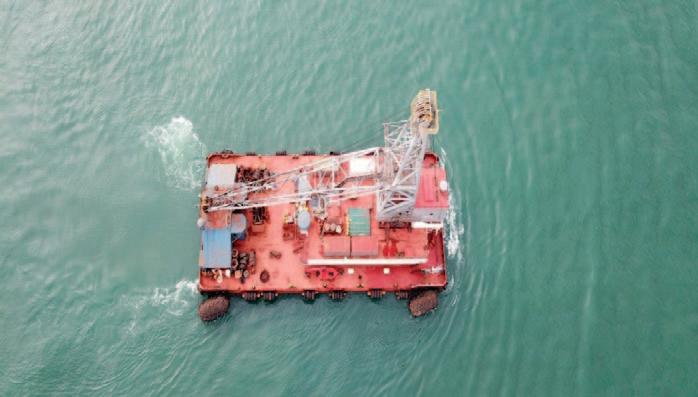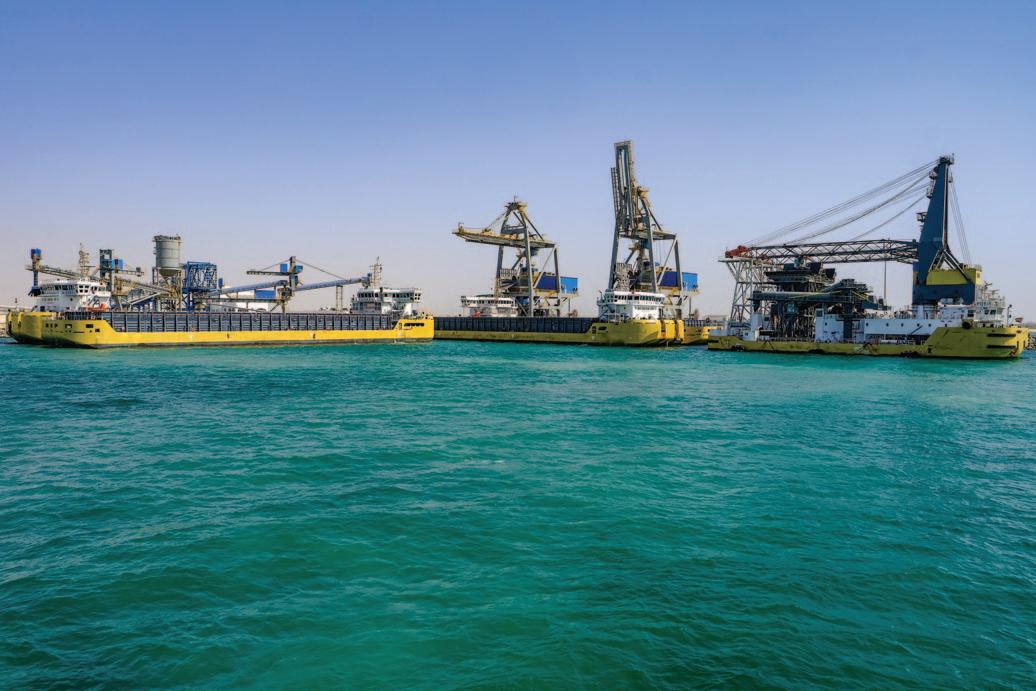
5 minute read
the market
Sierra Leone, Guinea, Colombia and Dominican Republic. At one point in time, it had its own shipyard which designed, engineered and constructed its own electric floating cranes which were successfully deployed in the offshore transshipment of iron ore and bauxite in India, Sierra Leone and Guinea.
LDPL owns and operates several types of floating cranes, with lemniscate or derrick jib design. It further enhanced its transshipment fleet by owning and operating transshippers of various types comprising of onboard storage, cranes and conveyors.
Not restricting itself to offshore transshipment equipment, LDPL took the lead in providing customized solutions for the transportation of dry bulk cargo from/to draught-restricted ports or jetties. It developed several kinds of dry cargo barges capable of manoeuvring themselves in shallow and constrained ports as well as being capable of carrying much higher cargo quantities compared to conventional barges, thus resulting in economies of scale for its customers. These custom-built deck cargo barges, called FAZEL, are equipped with thrusters which allows them to safely moor, unmoor and manoeuvre in draughtrestricted ports as well as offshore. LDPL has been able to provide environmentally friendly deck cargo barges capable of restricting dust emissions. Similarly its transshippers are also designed to ensure that dust generated in handling dry bulk cargo as well as cargo spillage is minimized.
LDPL is proud to have worked and currently works with reputed customers which are leaders in their respective fields. These include NOMAC, Adaro, Kideco, Sinarmas, Fomento, Emirates Global Aluminum, Harbin Electric International, Glencore, Vale, Banpu to name a few.

The biggest strength of LDPL is its ability to provide solutions in shorter periods of time and in a contractual format acceptable to its clients. It has provided customized shipping solutions to these large reputed industrial customers in contractual formats such as EPC, O&M, take or pay, joint venture, time charter and is always open to evaluating newer and different viable options. LDPL works closely with its clients, understanding their infrastructural restrictions and proposes commercially viable maritime solutions in the shortest permissible timeframe. These infrastructural restrictions can arise from draught restriction in navigation channel of port or its jetty/berth, air draught restrictions at port or in navigation, restrictions in turning circles, restriction in terms of length and beam of vessels, stockpile restrictions, cargo feed restrictions either onshore or offshore, cargo characteristics, weather restrictions and regulations. As required by the project, these transshippers are equipped with onboard sampling sensors, metal detectors, spill plates, liners for wet cargo, etc. The choice of the type of transshipment system to be employed is critically determined by cargo volume, weather working days, infrastructural restrictions, cargo characteristics, operational needs and targeted handling rate.
Below are some of the different transshipment assets that have been designed and/or built and/or managed by LDPL during the last few years:
TRANSSHIPPER/SELF-UNLOADER ‘ALM LOURA’
This 57,000dwt transshipper, is a Supramax which was converted in 2020. It is equipped with four 50t SWL Macgregor cranes and cargo handling plant comprising hopper, conveyors and shiploader. This asset specializes in the transportation-cum- transshipment of bauxite, mostly from Panamax vessels into Capesizes, in Guinea, West Africa for Emirates Global Aluminum. The cargo handling plant has a cargo handling capacity of up to 4,000tph (tonnes per hour).
TRANSSHIPPER ‘ALM TINKA’
This 5,000dwt transshipper, built in 2011, is equipped with two 36t SWL E-Cranes and cargo handling plant comprising hopper, conveyors and shiploader. This transshipper is also used in Guinea and West Africa for loading bauxite and exceeded loading rate of 40,000 MTPWWD (metric tonnes per weather working day).
FLOATING CRANE ‘MIRAMAR’
This 1,500dwt floating crane was built in 2009 by the LDA group company itself. The barge-mounted self-propelled floating crane has a 32t SWL, and is capable of loading and discharging several types of dry bulk cargo. The vessel was deployed at various locations including India, Sierra Leone and Guinea handling cargo such as iron ore and bauxite. It has been able to achieve iron ore loading rates in excess of 18,000–20,000 MTPWWD.

FLOATING CRANE TRANSSHIPPER UNITS ‘AL HAMRA’ & ‘AL MARIA 1’
The 1,350dwt floating crane transshipper unit built by LDPL in 2018 is an advancement of its floating crane. Both units are equipped with 48t SWL NKM Noell cranes and small hopper conveyor for the transfer of cargo from oceangoing vessels to barges. This means of cargo transfer reduces dust emissions and hence reduces environmental pollution. A shorter slewing angle at the same time ensures faster discharging rate. These cranes are operated by LDPL in Dubai for discharging coal. These cranes have been able to discharge coal in excess of 30,000 MTPWWD.

LDPL’S FLOATING CRANE HISTORY
Additionally, in the past LDPL has owned and operated several other floating cranes such as Maria Laura, Dona Paula, Dona Flora, Dona Zelia, Dona Nancy, Dona Adriana, Dona Felicia, Dona Lucia 1, Dona Sofia etc. at various locations in India, Indonesia, Romania and Colombia. These cranes achieved handling rates varying between 13,000–22,000 MTPWWD depending on cargo and barge sizes. These cranes not only served the purpose of dry bulk transshipment but also illustrated versatility in their usage by handling various kinds of hook operations too like lifting hatch covers of vessels, lifting broken jibs of crane etc.
These floating cranes also have an advantage in handling wet cargo while transshipping in areas with predominant rainy season. Direct cargo transfer method of floating cranes assists in relatively easier handling of wet cargo. All these transshipment assets were capable of loading or discharging vessels up to Capesize, giving customers the benefit of freight advantage.
BESPOKE BARGES
Below are some of the different bespoke barges that have been designed and/or built and/or managed by LDPL during the last few years:
Self-propelled barges (SPB): ALM v Aquila, ALM Aquarius, ALM Austral and ALM Aries. These 13,000dwt deck cargo barges were custom built between 2019 and 2020 for Emirates Global Aluminum’s project in Guinea. These self-propelled twin-screw barges were capable of berthing/ unberthing using their own power at shallow draught bauxite loading jetties. Due to their customized design, these vessels could carry over 12,500 metric tonnes of cargo on a draught of 5.70m, which is significantly higher than conventional barges of the same draught in seawater.
Full Azimuthal Electrical Propulsion v Barges (FAZEL): Al Khair, Sana 1, Al Dana 1 and Aseela. These 5,800dwt barges were custom built in 2018 for the Harbin Electric International project in Hassyan, Dubai. These barges are equipped with azimuth thrusters rendering them ultra-high manoeuvrability at 3.80m draughtrestricted jetties. Due to their customized design, these barges are capable of carrying over 5,500 metric tonnes of coal in seawater.


LDPL’S BARGE HISTORY
In past LDPL has owned and operated standard barges as well as customized barges for various clients in Indonesia. These barges (standard or custom built) were used for the transportation of coal either from mine to power plant or mine to offshore location for transshipment into oceangoing vessels. Additionally LDPL also owned and operated various tugs for movement and assisting purposes of these barges.
Apart from above LDPL is also involved in shore handling projects where it acts as port operator for operation and maintenance of harbour cranes employed for loading/discharging dry bulk cargo for example in Dubai and Indonesia. It also offers consulting and ship management services to third party ship owners for customized vessels. This makes LDPL a niche full marine logistics service provider capable of offering ons-stop-shop for all the transportation-cum-transshipment needs of its clients.
Environmental Stewardship
LDA, LD T&L and LDPL, being very conscious of their responsibility in reducing carbon emissions from shipping, are actively working on alternate fuel as well as wind-assisted propulsion vessels which will reduce greenhouse gas emissions.
It has successfully conducted trials on vessels operated by it using hydrogenated vegetable oil, non-fossil biofuel in Europe. LDPL has also recently been granted an Approval In Principle from an IACS class society for a maritime logistic solution dedicated to green ammonia and hydrogen called FRESH.










